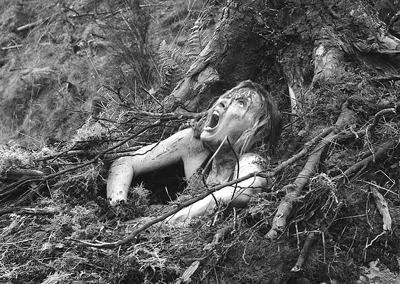Spelunking slaughter filled with barely concealed vaginal, phallic allusion
Well before the 2004 election made the blue state/red state divide a media cliché, it was explored metaphorically in films like John Boorman’s “Deliverance,” Tobe Hooper’s “The Texas Chainsaw Massacre,” and Wes Craven’s “The Hills Have Eyes.” The horror genre has spent the past 35 years depicting urbanites’ nightmares about the great outdoors and its denizens. “The Descent,” set in Appalachia but shot in the U.K., continues this thread, putting a female twist on the male fears of “Deliverance”—all six of its characters are women.
Even by a horror fan’s standards, watching “The Descent” is a masochistic experience. On the way to the cave, one spelunker reels off a list of the mental dangers her companions face in the dark. The film itself provides a vicarious immersion in claustrophobia and disorientation. I’m not sure if it’s intended for nature lovers or people who want to exercise their schadenfreude regarding them. The fact that the cast is all female suggests feminist intent but “The Descent” is no ode to female bonding. At its most ambitious, it leans towards a blood-soaked exploration of women’s power dynamics and resentments.
Sarah (Shauna Macdonald), Juno (Natalie Mendoza), Beth (Alex Reid), Rebecca (Saskia Mulder), Holly (Nora-Jane Noone), and Sam (Myanna Buring) get together for a trip in a national park. Sarah is recovering from the death of her husband and daughter in an accident. They rely on Juno’s expertise to get them through the experience of exploring a little-known cave safely. According to a guidebook, there are three entrances, so they should be safe. However, a rock fall traps them underground, and it quickly becomes apparent that Juno doesn’t know as much as she claims. In fact, they’re in a cave that’s rarely been explored—no one knows the way out. The presence of murderous humanoid predators makes a bad situation even worse.
“The Descent” is most successful at creating a world to explore and get lost in. Although the cave was created on a set—and enhanced with matte paintings and other special effects—it’s an utterly convincing simulation. Long before any blood is shed, the screen is filled with ick and goo. At first, the cave’s mist and streams of water look pretty and appealing, but as the spelunkers’ situation grows more desperate, it becomes uglier and uglier. Soon, it turns into a murky maze, full of tiny, treacherous passageways.
The experience of watching “The Descent” is sometimes akin to playing a video game—or at least watching someone else play one—as the characters have to fight off monsters and climb over wide pits. Neil Marshall’s direction relies on strange camera angles—they’re a tip-off that the film was shot on a set, as most of them would be impossible to stage in a real cave. Together with the lack of light—which will make the film almost unwatchable on DVD—they succeed in destroying the spectator’s sense of space and making one feel as lost as the characters. However, the dimness tends to make the actors indistinguishable.
If “The Descent” is not exactly a pleasant place to spend 99 minutes, it’s a memorable journey. The setting is rich with metaphor, evoking the unconscious and various body parts—judging from Vivian Sobchack’s article on the film in “Film Comment,” academic exegesis has already begun, with more certain to follow. Vaginal and phallic imagery is so blatant that it barely qualifies as subtext. The monsters imply evolution in reverse; Marshall’s use of actors in heavy prosthetic makeup to play them, rather than relying on CGI, was a brilliant idea. They’re just human enough that the resemblance is truly frightening.
As storytelling, the film is far more flawed. Its attempts at backstory merely set up the characters as lunch for the humanoids. Their antagonisms are ineptly developed. One senses that Marshall is aiming for something larger than merely scaring the audience, but he doesn’t really achieve it. His weakness for fake scares—nightmares, an image that suggests the shower scene from “Psycho” but turns out to be innocuous—doesn’t help. Marshall’s heart lies mainly in making the audience jump—his shock tactics include deafening sound design.
The ads for “The Descent” proudly tout that it comes “from the studio that brought you ‘Saw’ and “Hostel,’” but it plows its own road between those lame wallows in torture and recent American J-horror retreads. As gory as it is, it reflects real imagination, not just sadism, even if it never turns out to be much more than a thrill ride.
gaycitynews.com
































